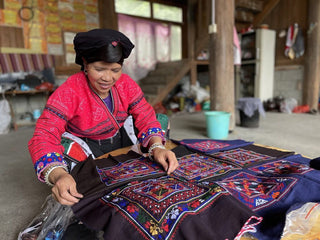***For the most recent update about this Beautiful Reason Initiative (BRI),
please scroll down to the Project Updates Log or click here.***
Last updated: January, 2022
Beautiful Reason Initiative #2:
Red Yao Embroidery Program
Table of Content:
LOCAL NEED
The inspiration for this Beautiful Reasons Initiative (BRI) came in early 2021. Farming season was over, and the Aunties were spending most of their time working on embroidery projects. (During our trips, we've learned a lot about this beautiful tradition, and you can read all about it here: LINK)
The Aunties asked us what we thought of their embroidery (we LOVE it!) and if we or anyone we know would be interested in purchasing some. At the same time, our customers frequently asked us about the Red Yao outfits and ornaments and whether they could purchase these.
So, naturally, this seemed like the perfect fit for our second BRI project.
But, there was one thing that concerned us...
Could we help facilitate a market for their beautiful embroidery while also protecting this ancient tradition from becoming overly commercialized? It was a big question to grapple with-- and one that took a lot of thoughtful consideration.
The Red Yao people very much see their sewing and embroidery as something integral to their daily life-- and even to their happiness. The fact that they sew every spare moment they have, even though they have many finished pieces in storage, shows that this skill reaches far beyond being a necessity.
Embroidery to them seems like a meditation, a spiritual practice.
We wanted to be sure that the beauty and essence of this cherished tradition would not be diminished by bringing their work to market. At the same time, we also want to adhere to and respect the Aunties' interests and desire to improve their economic stability and have more people experience their ornaments.
In collaboration with the Aunties, we reviewed the local needs, opportunities, and potential outcomes the project could support. We ask our usual "What if..." question and found the answer quite inspiring. (In case you missed it, our process for choosing new BRI projects is outlined in detail here.)
Here's a look at how we evaluated the embroidery project, initial investment, and timeline plan.
(*Scroll to the bottom for our most recent on-the-ground update for this project*)
First, we evaluated local needs...
Need#1: Improve the economic stability of the Red Yao Women by connecting them with customers interested in their embroidery culture.
Next, we made sure the initiative was in line with BRI's core values and would positively contribute to the community's sustainable development without disturbing existing local harmony.
Helping increase economic stability is certainly aligned with our BRI project criteria and enough reason in itself to support this initiative.
But there is another excellent reason we chose to launch this project-- cultural preservation.
This second BRI project will also help the Red Yao preserve their sewing traditions -- an important part of their culture.
We have heard from Red Yao elders that they expect much of their culture will be lost within one generation. The freedoms that come with new rural-urban mobility are viewed as great improvements; however, they come with a tradeoff.
Younger generations leaving the village to pursue opportunities elsewhere won't be able to uphold some of the traditions that have always defined the Red Yao people.
Their exquisite, vibrant embroidery is one of those traditions at risk of disappearing.
So, in evaluating this project and in discussions with the Aunties, we all started to ask--
What if... a new market for their embroidery work could provide the Red Yao women with more economic stability and create new jobs to reverse some of the urban migration?
This would benefit everyone while preserving (and celebrating!) an important part of the Red Yao culture.
With the Aunties, we identified this as the second local need that a potential BRI embroidery project would address:
Need#2: Create new employment in an industry that is core to the culture and identity of the Red Yao Women.
OPPORTUNITY (BRI)
To meet both of the above local needs while remaining true to the BRI principles, we're starting with a pilot program.
Seven Aunties will be offered contracts to create handmade embroidery ornaments. They'll have complete creative freedom to produce pieces they think best represent their culture.
Viori is committed to:
- Guaranteeing steady income for seven Aunties by agreeing to purchase their local embroideries for customer gifts. On the ground, we've helped set up a local co-op to determine a fair price for their embroidery work collectively.
- Providing support if demand is so great, the pilot program turns into something bigger.
In a supporting role, we will ensure:
- As many Aunties as possible can join the program.
- The new micro-industry doesn't disrupt the essence of Red Yao embroidery and culture.
- Social-entrepreneurial Aunties receive mentorship in running their embroidery business.
TIMELINE 2022
Milestones:
TIMELINE 2021
- Dec: Overall program evaluation and future proposal
BUDGET
Last updated: January, 2022

Project Updates Log
December, 2021: Viori customers receive Yao Embroidery as Christmas gifts
This week was the moment we've all been waiting for: handing over some of the incredible Yao embroideries to some of our lucky customers. They amount of positive feedback receive is a great encouragement to continue the embroidery program, which leads to financial stability to an increasing number of Yao women. We couldn't have wished for a better Christmas gift! 
Aug, 2021: Second batch of Yao Embroidery received!
After several months of sewing the local female co-op manager packages the second batch of local embroideries and sent these to us here in Utah. Thank goodness postal companies are reliable these days! We receive all items in good shape with name tags and all. Excited to share these with customers soon! 
June 20, 2021: Aunties receive name tags!
Today we had a heartwarming moment felt by everyone involved in this project. We gave each Auntie a name tag created especially for them by our talented Design Team. There were smiles on every face-- truly a special occasion.
May 25th, 2021: First batch of embroideries items complete.
With excitement, the local co-op manager Pan Zhi Mei collects the embroideries received by all the Aunties. Pan Zhi Mei volunteered to be the co-op manager, meaning she'll be in charge of quality control and shipping finished pieces to the Viori warehouse in Utah.
The administrative work involved in creating a co-op for the villagers to sell their local products proved more work than expected, but luckily Viori's local team in Guilin will help.
April 15th: Local Co-op + Name tag design
This week Viori assisted some villagers with getting their Cooperative (co-op) registered.
Co-ops are business entities that bundle the resources of individual members. This makes it easier for individual members to gain market access and manage administrative work, which can be challenging when done alone. Co-ops are often democratically run; members vote on decisions and choose co-op directors.

Another big milestone this week was the completion of the embroidery team's name tags. Each Auntie now has a personal name tag, with her story and picture on it. This labor of love completed by Viori's design team will be much appreciated in the village!

March 20th, 2021: Red Yao embroidery
Much of this trip was spent doing research on the Red Yao embroidery culture. It ended up sparking the inspiration for this BRI project. To learn more about the Red Yao’s embroidery culture, check out this article.
February 17, 2021: First Time Back
This was our first trip back to Longsheng since the start of COVID and travel challenges/restrictions.
We stayed in touch with local families throughout the year, but not having our team be on the ground in Longsheng felt unnatural, especially while our company was rapidly evolving to adjust to the circumstances.
So, this trip meant a lot to us...
And it was amazing. We are so grateful to have reconnected with our Longsheng friends in person and reaffirm our commitment to supporting their culture. We're also grateful for the stories and the laughs.
We always have a great time on our visits. And this was such a unique trip that we wrote a separate article about it called 'Coming Home.' Read it here.
While listening to the stories shared by community members and restating our commitment to their sustainable development, we came up with some exciting ideas for supporting the Red Yao people of Longsheng. Stay tuned for more!

